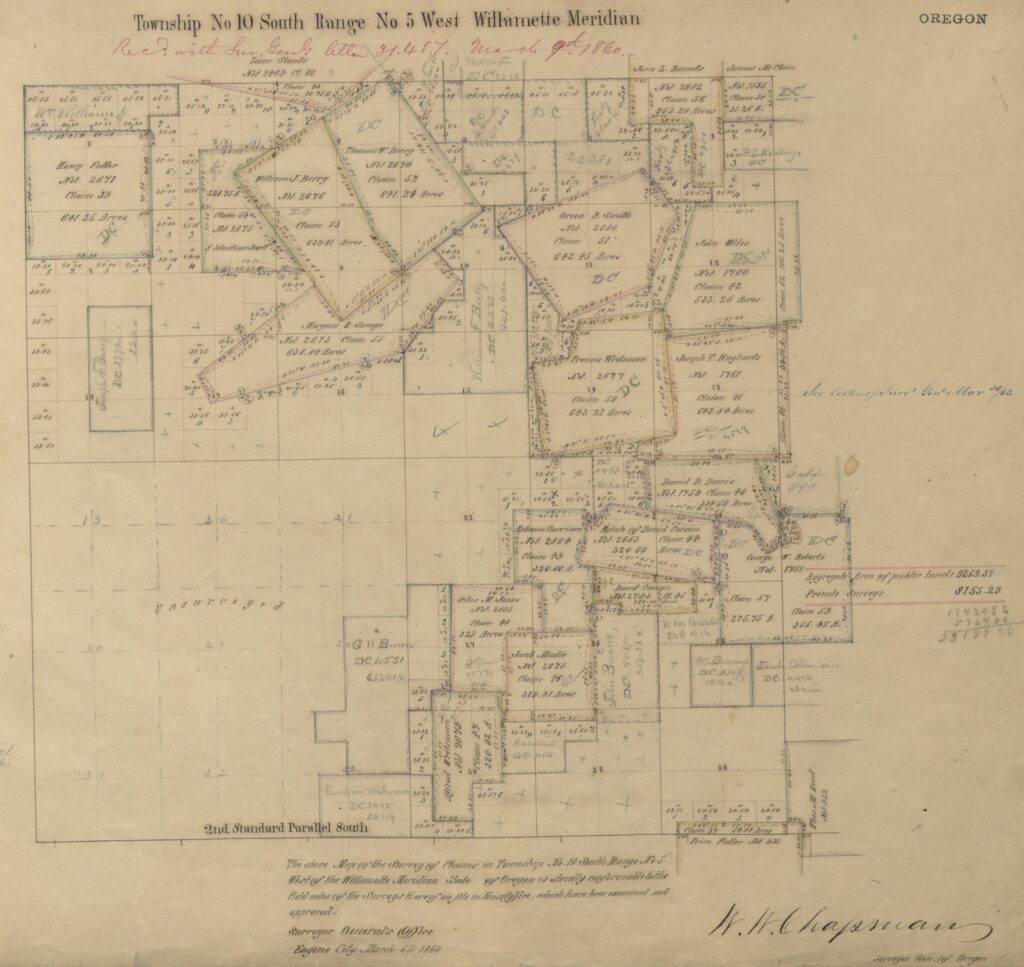Letitia Carson was born into slavery in Kentucky between 1814 and 1818. David Carson was born in Ireland in 1800 and likely came to the United States in the 1810s or early 1820s. It is not known when or how David and Letitia came together or when Letitia was granted her freedom, so the nature of their relationship is unclear. However, the two raised a family in Oregon, and details suggest they lived together consensually.
Letitia and David migrated to Oregon from Missouri in May 1845 with nearly 1,000 other emigrants. During the trip, along the North Fork of the Platte River in what would become Nebraska, Letitia gave birth to their first child, Martha Jane. The family arrived in Oregon in the fall of 1845. In December, David trekked south into the mid-Willamette Valley, and under the Oregon provisional government’s land laws, made a claim for 640 acres –the amount entitled to married couples — of mostly native prairie in the Soap Creek Valley.

They likely built their homestead, close to Soap Creek, in the spring of 1846. They began raising cattle (Letitia was the primary cattle-raiser) and hogs; they planted crops including potatoes and likely established an orchard. The Applegate Trail ran close to their homestead, and it is probable that the Carsons sold produce, dairy products and meat to travelers on the road.

In September 1852, David Carson passed away. Because he had not made a will, a nearby Soap Creek resident, Greenberry Smith, was named administrator of David’s estate. Smith and his family had also migrated to Oregon in 1845, so it is possible that the Smiths and Carsons knew each other while on the trail to Oregon. Smith did not recognize Letitia or her children as David’s rightful heirs, either because she was Black or because he considered her still enslaved. In early January 1853, Smith held an auction of David’s possessions. Letitia had to spend $104.87 to buy back some of her family’s basic possessions, including bedding, cookware, and a few head of cattle, in order to survive.
Soon after that, Letitia and her two children relocated to Douglas County. But Letitia Carson was not through with Greenberry Smith. In February 1854 Letitia filed suit against Smith as the administrator of David Carson’s estate. She was represented by Corvallis attorney Andrew Thayer. The gist of her complaint was that if Smith did not recognize her as David Carson’s legal heir, then she was due back wages — in the amount of $3,750 for the seven years she had been with David — and damages of $5,000. She also made a claim of nearly $2,500 for the unlawful sale of her cattle. She later reduced the labor claim to $1,000. Both nephew Andrew J. Carson and David Carson (Jr.) were subpoenaed to testify, as were several neighbors. In May 1855, the jury found in her favor on the labor issue, but she only was awarded $300 plus $222.20 in court costs.

Photo courtesy of Joey Lavadour
Attorney Thayer filed a second suit in August 1855 pertaining to Letitia’s cattle. One witness, a neighbor, confirmed that Letitia had owned and raised most of the cattle. In October 1856 the judge in the case issued a judgment in Letitia’s favor, awarding her $1,200 plus nearly $200 in costs.
Letitia Carson’s noteworthiness did not end with her successful lawsuits. On June 17, 1863, she filed a claim for 154 acres In Douglas County under the federal 1862 Homestead Act. Five years later her claim was one of the first seventy-one claims certified in the U.S., and most likely the first claim by a Black woman in Oregon.
The Carson lands were sold in 1857, and from that time until the federal government purchased the lands in 1941 for the Camp Adair cantonment, they mostly were used for cattle grazing and haying. The use of the land for military training during WWII seems to have had minimal impact on the landscape. In 1948 Oregon State University acquired 6,200 acres of the former Camp Adair lands from the federal government, including most of the Carson lands and what became the Dunn Forest. Today much of the Carson land is open prairie, used for beef cattle grazing by Oregon State University’s beef ranch. There are no visible remnants of the Carson homestead or farm outbuildings; they were demolished, moved off site, or allowed to deteriorate after Letitia Carson was forced to leave her homestead and the Carson Estate DLC was sold in 1857.
